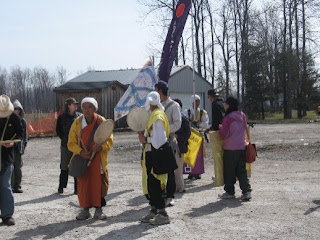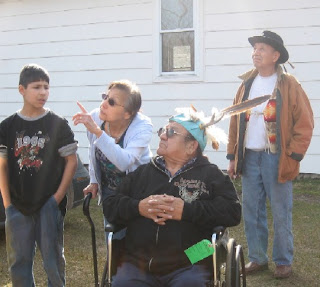Two days after we left the Tuscarora Nation in the Town of Lewiston, we arrived at the Seneca Nation’s Tonawanda Territory. This territory straddles two counties — Erie and Genesee — and the town closest to it is Akron.

When we left Lewiston, we traveled east through Sanborn until we arrived in the City of Lockport, where we spent a night at the YWCA. Lockport is located right on the Erie Canal and is named for the locks that were built in the 1840s. The next day, we left Lockport and walked to the Seneca Nation’s Tonawanda Territory. Mostly, we walked on either Akron Road or Old Akron Road.
At the edge of the Tonawanda Territory, we were welcomed to the Seneca Nation by Chief Hill and by several clan chiefs. Chief Hill offered a prayer for peace in the Seneca language. This prayer was then translated into English. Jun-san then translated the prayer into Japanese for the benefit of the Japanese members of our group. After we had been welcomed, we walked to the Long House, where we had another welcome. I learned that there are two entrances to the Long House. One is for men and the other is for women. We also were told that the building behind the Long House was where we would have our dinner and where the women would sleep for the night. The men were to sleep in the Long House, which is a bigger structure. We have more men than women in our group, I found out.
 Dinner proved to be very delicious. We had our choice of bean burger or buffalo burger. I had a buffalo burger, as I had never tasted one of those in the past. I was told that buffalo burger is very low in cholesterol, unlike the more typical hamburger, which can boast a very high cholesterol count. I was happy to put fresh tomato slices and lettuce on my burger. We also had sweet potatoes, salad, and applesauce. For dessert, we ate strawberries.
Dinner proved to be very delicious. We had our choice of bean burger or buffalo burger. I had a buffalo burger, as I had never tasted one of those in the past. I was told that buffalo burger is very low in cholesterol, unlike the more typical hamburger, which can boast a very high cholesterol count. I was happy to put fresh tomato slices and lettuce on my burger. We also had sweet potatoes, salad, and applesauce. For dessert, we ate strawberries.
After dinner, Darwin Hill offered us some interesting information. We were told that this flag is a replica of a 1,000 year old Hiawatha wampum belt. It is now the flag of the Haudenosaunee Confederacy. They are also known at the Iroquois Confederacy. The six nations of the Confederacy are the Seneca (Keepers of the Western Door), Tuscarora, Onondaga, Oneida, Cayuga, and Mohawk (Keepers of the Eastern Door). We also learned that, before the European invasion, the Senecas had been located in the Genesee valley, which is east of their current location. Two hundred years ago, Darwin Hill said, the Senecas were pushed away from their homeland by the settlers.
“Very few people stayed in their original land after the European invasion,” Darwin Hill said, adding that the Senecas were fortunate that they did not move too far from their original home, unlike some other nations. The Cherokees and the Creeks, for example, were forced off of their ancestral land in the southeast and made to walk all the way to Oklahoma on the Trail of Tears. Take a look at the history of the Trail of Tears. During this forced march of well more than 1,000 miles in the 1830s, many men, women, and children died. It was one of the cruelest and saddest moments in U.S. history.
Darwin Hill also told us that the Haudenosaunee Confederacy has been trying to get a resolution to the issue of stolen land for years. Currently, they are working on resolving that issue in the United Nations, where they are recognized as nations, rather than as “NGOs” (non-governmental organizations). He explained that, since the 1980s, there has been a working group on indigenous populations in the United Nations. The Declaration of the rights of Indigenous Peoples came about in 2007. Take a look at the declaration . Only four nations did not vote for it. Those four nations are the United States, Canada, New Zealand, and Australia.
The United Nations also has a Permanent Forum on Indigenous Issues.
“The United Nations has no police force. It is a very slow acting body but, at least, we have a forum,” Darwin Hill said, adding, “We are recognized in the United Nations but not in the United States or in Canada.”
Another topic of discussion that evening at the Long House was the whole issue of war versus peace. In the 1960s, many Native American men were drafted into the Army and were sent to fight in Vietnam. Currently, many are serving in the military in Iraq and Afghanistan.
“It’s a conflict that we have to deal with,” Darwin Hill said. “It conflicts with our message of peace.”
Darwin Hill said that, 1,000 years ago, the Haudenosaunee Confederacy buried their weapons of war.
Yukio, who is one of the walkers, offered a Japanese perspective. He said that, after World War II, Japan adopted a peace constitution, which prohibits Japan from having a military or from fighting wars. Now, he said that the United States wants Japan to have a military. Yukio does not like this so he decided that he would walk for a nuclear-free future and to bring a message of peace to the United Nations.
Another walker, Al, is a Cayuga who lives in the Seneca Nation’s Cattaraugus territory. He said that, during the Vietnam War, he made the decision that he would not fight in the war. He took a man named Mad Bear with him and went to the FBI. He told the FBI that they could arrest him but that he would not fight in the war. He was not arrested.
He talked about the Creator as a peacemaker and said, “There will be no more wars from us. We’re all the same people on Turtle Island. We need to have peace again. That’s why I walk with you.”
